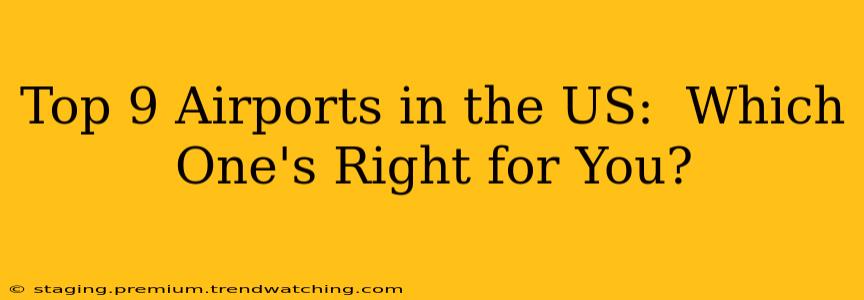Choosing the right airport can significantly impact your travel experience. With hundreds of airports across the United States, narrowing down your options can feel overwhelming. This guide focuses on nine of the busiest and most significant airports, helping you determine which best suits your needs based on location, amenities, and airline connections. We'll consider factors beyond just size, looking at what makes each airport unique and appealing to different types of travelers.
Methodology: This ranking isn't about declaring a definitive "best" airport. Instead, it presents a diverse selection based on passenger volume, location, airline partnerships, and amenities, catering to various travel preferences. The airports are not ranked in order of preference, but rather categorized for easy comparison.
Top Tier: Major Hubs with Extensive Connections
These airports serve as major hubs for numerous airlines, offering extensive domestic and international flight options. Expect larger crowds and more extensive facilities.
1. Hartsfield-Jackson Atlanta International Airport (ATL): ATL consistently ranks as the world's busiest airport, boasting a massive network of domestic and international connections. Its sheer size and connectivity make it a convenient hub for travelers regardless of their final destination. Expect a wide range of amenities, including numerous restaurants, shops, and lounges. However, be prepared for potential crowds and longer walking distances.
2. Dallas/Fort Worth International Airport (DFW): DFW, another massive hub, excels in connecting travelers across the country and internationally. It’s known for its efficient design, although its size still requires ample time for navigation. Similar to ATL, expect a comprehensive selection of amenities to cater to diverse needs.
3. Denver International Airport (DIA): DIA stands out with its unique architecture and relatively easy navigation despite its size. It features a robust network of domestic and international flights, along with ample amenities and a strong focus on passenger convenience.
Mid-Tier: Excellent Balance of Connectivity and Amenities
These airports offer a strong balance between connectivity and a less overwhelming atmosphere than the major hubs.
4. Chicago O'Hare International Airport (ORD): ORD is a significant hub, offering many domestic and international connections. While it can be busy, its layout generally feels less sprawling than ATL or DFW. A good mix of amenities is available.
5. John F. Kennedy International Airport (JFK), New York: JFK, serving the New York metropolitan area, is a major international gateway. It offers flights to destinations worldwide, but navigating its terminals can be challenging. Amenities are plentiful, reflecting its status as a major international airport.
Smaller Hubs with Specific Strengths:
These airports may have fewer direct flights, but excel in specific areas or serve particular niches.
6. Los Angeles International Airport (LAX): LAX, a major West Coast hub, boasts strong international connections, particularly to Asia and the Pacific Rim. Expect high passenger volume, especially during peak hours. The airport has recently undergone significant renovations to improve passenger flow and facilities.
7. San Francisco International Airport (SFO): SFO is known for its modern design, excellent amenities, and strong international connections. It offers a more relaxed atmosphere compared to some of the larger East Coast hubs.
Niche Airports:
8. Orlando International Airport (MCO): MCO, primarily serving the Orlando tourist market, is designed to handle high passenger volume during peak seasons, particularly surrounding major theme park events. While its connectivity is more focused on leisure travel, it's efficient at managing large crowds.
9. Phoenix Sky Harbor International Airport (PHX): PHX is a Southwest hub, known for its well-organized design and relatively easy navigation. While international connections exist, its focus is largely domestic.
Frequently Asked Questions (FAQs)
Which US airport has the most international flights?
While several airports have a large number of international flights, JFK consistently ranks among those with the most. However, the number of international flights can fluctuate based on seasonal demand and airline schedules.
What is the easiest US airport to navigate?
This is subjective, and depends on individual preferences. Some travelers find Denver International Airport (DIA) surprisingly easy to navigate given its size, while others appreciate the relatively straightforward layout of Phoenix Sky Harbor International Airport (PHX). Smaller airports generally tend to be easier to navigate than massive hubs.
Which US airport has the best amenities?
Many airports offer excellent amenities, but airports like SFO and DIA are frequently praised for their modern facilities and extensive selections of shops and restaurants. However, the best amenities will depend on your personal needs and preferences.
Which US airport is best for connecting flights?
ATL and DFW are generally considered the best for connecting flights due to their extensive networks of airlines and routes. However, connection times should always be carefully checked when planning itineraries.
Choosing the "right" airport ultimately depends on your individual needs. Consider your destination, preferred airlines, desired amenities, and tolerance for crowds when making your selection. This guide provides a starting point for researching and selecting the perfect airport for your next journey.

